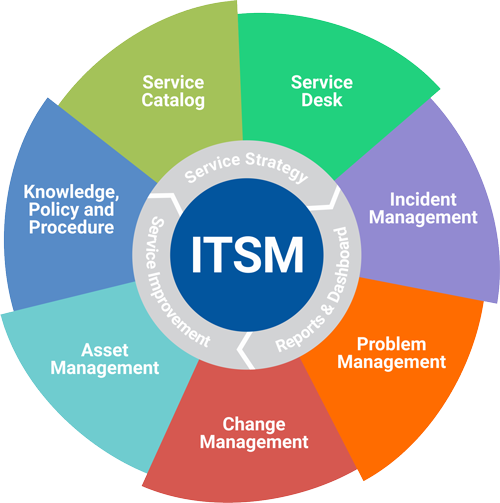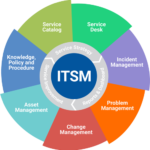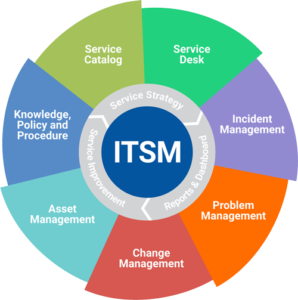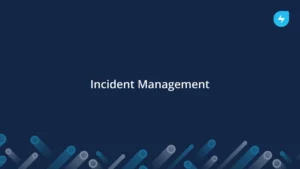IT Service Management (ITSM) provides a framework that enables organizations to deploy and manage IT services strategically and effectively. The IT Service Management process can be deciphered into five main steps: Plan, Deliver, Monitor, Control, and Optimize. It can also be divided into two distinct activities: Operations and the Service Management Lifecycle.
What is ITSM
ITSM is a collection of processes that are used to manage IT services. It includes the management of people, processes and technology to provide the best service for customers at the least cost.
What are the benefits of ITSM?
The benefits of ITSM are reduced downtime, increased customer satisfaction and revenue, lower cost for hardware and software maintenance. As a result, there is less need to purchase new equipment as well as the need for less staff.
IT Service Management software helps improve efficiency and productivity by making sure that IT systems are functioning properly. ITSM software can help an MSP reduce costs and mitigate risks by building a predictable IT organization. With improved customer experience, ITSM can provide its customers with a more consistent service.
What is an ITSM tool?
ITSM is an acronym that stands for Information Technology Service Management. ITSM tools are used to help organizations manage the IT service lifecycle, including planning and managing services both on-premises and in the cloud, executing projects to deliver IT services more efficiently and effectively, gathering feedback from customers on their satisfaction with service levels.
An ITSM tool is a software application that helps organizations manage the IT service lifecycle. ITSM tools can help organizations plan and manage services both on-premises and in the cloud, execute projects to deliver IT services more efficiently and effectively, gather feedback.
In addition to providing services such as software, ITSM tools also provide a CMDB and service desk. A service desk is responsible for 3rd party contracts, monitoring of services and providing support in case of downtime.
ITSM vs ITIL
ITIL can be described as a set of guidelines that are used to “manage IT service delivery” It is often referred to by the acronym ITSM. The 4 sets of processes that are used in ITIL, as well as its guidelines for measuring and handling incidents, make it a much more detailed methodology.
ITSM stands for IT Service Management, which is a framework that guides how services are managed. ITSM was developed by American business consultant Gene Amdahl in 1995 and later adopted into the service management model of the United Kingdom’s government-sponsored National Health Service (NHS).
ITIL is an acronym for Information Technology Infrastructure Library. It has been around since 1988 when it was created by British information technology consulting firm Capgemini with funding from NHS to deliver IT infrastructure services. ITIL was developed by the United Kingdom’s National Health Service and is supported in countries such as Canada, Australia, New Zealand.
The difference between these two acronyms is that ITSM focuses on service management whereas ITIL addresses infrastructure services.
Why does your business need ITSM?
It is widely acknowledged that IT is a complex and expensive undertaking, which requires specialized knowledge and skills. It’s not uncommon for organizations to rely on vendors or consultants to stay abreast of the latest developments in IT. To manage this complexity, organizations must have a sound strategy for managing their IT assets and resources effectively. A key component of such a strategy is an IT Service Management Strategy which, in general, refers to the process of managing IT services.
Service management is a process that includes the activities involved in managing service processes, assets and people. The ITSM framework provides an easy-to-remember toolkit of stages to help organizations focus on what they need most at any given time.
The benefits of having this system include improved customer satisfaction, increased competitive advantage and reduced costs such as decreased downtime or labour expenses for example.
ITSM processes
There are many IT service management processes, but the following are considered to be some of the most important ones. The first is Configuration Management Processes which defines how the software will be managed throughout its lifecycle. The second process is the Service Delivery Process which defines how IT should deliver services to customers promptly while maintaining quality. Lastly, there are Business Continuity Management processes that define what to do in the event of an emergency.
The IT service management processes are very important because they define how the software will be managed throughout its lifecycle.
Service Request Management
Service request management is a repeatable procedure for dealing with customer service requests. It often involves recurring requests and benefits from automation, making it an ideal workstream to be automated.
Knowledge Management
Knowledge management is a multidisciplinary approach to achieving organizational objectives. It can be broken down into four main parts: 1) Knowledge creation 2) Knowledge sharing 3) Knowledge use and 4) Managing knowledge.
To create, share, use or manage knowledge in an organization, the organization must have a system for managing it.
IT Asset Management
IT asset management is a process that tracks assets in an organization. It ensures they are accounted for, deployed, maintained, upgraded and disposed of when the time comes. These tangible or intangible items include hardware devices such as computers and servers, software licenses or subscriptions, website content, email messages or contacts.
Incident Management
Incident management is the process to respond to unplanned events and services. Many software companies rely on these systems, so the incident response must be ready for quick response and resolution.
Problem Management
Problem management is the process of identifying and managing causes for incidents. Identification and understanding of cause are important to problem management. The results are having a better understanding of incidents and root causes, which allow companies to take proper actions to prevent future occurrences.
Change Management
A Change Management Plan is a document that provides a roadmap of the changes to be made and preparations for those changes. The plan should clearly outline what needs to happen, who will do it, and when. It can also include a budget for the change and may need to be approved by upper management before it is implemented.
A Change Management Plan is typically used in businesses that are implementing a new system, such as the installation of an ERP program.
The first step in preparing for any change is to identify what changes will take place and when they will happen.
Start Your ITSM Journey today
Sign up for EasySM and start streamlining your business processes.










